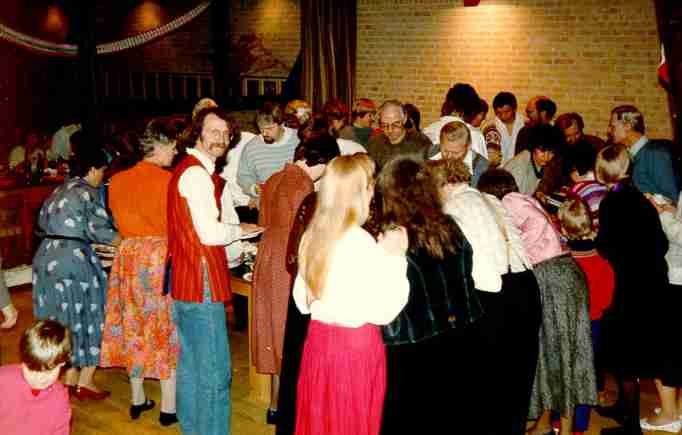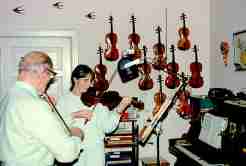Folk dance music with improvisations
Bondepigen (Peasant Girl)
|
| Niels Mejlhede Jensen, Bøgeløvsvej 4, 2830 Virum, Denmark.
e-mail
(web master) |
Old tune used for folk dancing in Denmark 1999 arranged with improvisations
Link to index to other dances.
CONTENTS: (remember: you can use Ctrl Home in usual browsers
to get to the top of this page, to the links here)
-
Dance of the week 1999 March 15: Bondepigen
(Peasant Girl), 3 persons' dance
-
Dance description, will open on
a new page, in a new window, so that this window with music is kept behind
-
Music description (you stay on this page)
-
Performing proposals
(new page, in a new window, with this window behind)
-
Music scores for C, A , Bb, Eb, F, and bass
instruments (to text on this page)
-
(c1, c2),
(a1,
a2),
(b1, b2),
(e1,
e2),
(f1,
f2),
(bass1, bass2);
(note sheet will open on a new page, help here)
 |

Photo of a lovely peasant girl ? (the name of the dance this week).
Well, when I first learned to know her, she lived in the most cute little
thatched roofed farm place, where her husband was forest guard. Besides
dancing folk dances and assisting her husband in instructing them, she
plays amateur theatre, and joins in on other local cultural initiatives.
So folk dancers and musicians are often active in more than one field. |
Photo 1 of this week: A fiddler has 80 years' birthday, so some
of our beautiful girls give him the opportunity to observe their foot work
in folk dancing.

Photo 2 of this week: Dinner is served. Next dinner party will
be Friday 9' of April, 1999 at 18 hours (6 pm). Everybody is welcome, at:
Lindegården (old yellow thatched roofed farm, across the courtyard,
into the barn), address: Peter Lunds Vej 8, Lyngby (12 km north of Copenhagen
Centre). Come with some food of yours and place it on the table, and see
it disappear. Hopefully you in exchange get some delicious (and unusual?)
food too. Free admission, but 20 kr (= $3) for 2 cups of coffee or tea
includes the rent of the farm for the evening.
A little story:
The dance of next week will be the Blacksmith's 1' Schottische. In the
same way we have polkas and waltzes named after the blacksmith. So the
blacksmith was often the fiddler of his region. My father's great grand
father, Niels Hansen, was the blacksmith and fiddler for his region in
Vendsyssel in Northern Jutland. When Niels was 28 years old the King gave
the music free in Denmark (in 1830), and Niels could now play his fiddle
legally. And so he did around at many places: at market places and at dances.
He was lucky to experience the so-called golden age for folk dancing and
folk music 1830 - 1860, where his music was welcome everywhere. Niels is
said to have played good dancing music, and he could read and write music
notes, which was unusual. Niels had a small farm which was a copyhold (fæstegård)
under the manor of the former monastery Børglum Kloster. He had
2 horses and 4 cows. And then he was the blacksmith. When we had
repair work done by the blacksmith in my childhood we delivered the machine
at his place and came to get it a few days later. But 100 years earlier
there was much more festivity in doing this iron work. The farmer that
needed the teeth of his harrow to be repaired had to bring the coal and
iron himself and came and stayed all day at Niels's place. Niels did the
iron work and then the farmer in return had to do Niels's field work. The
farmer brought all the food for the day, and - brandy. At such a meal,
and with the alcohol, there was a lot of news to talk about, because Niels
came many places and experienced much. During the summer Niels made some
smaller iron things like bread knives, and then he went around to market
places during the autumn to sell them, and to play his fiddle. Market places
with music and brandy, that was good time for him. He was often gone for
several days, and seldom returned home with money. Home to his wife and
children, who in the meantime had to take care of their farm. When he was
out to play to parties he did so for food and alcohol, money was scarce
among farmers at that time. Alcohol was a problem for many fiddlers. The
two highly estimated fiddlers of Vendsyssel, Swedish Niels and Niels Dakota,
more or less drank themselves to death. Blacksmith Niels was not quite
so bad, but my family before me was not proud of him. When he died in 1875
he left a pile of music notes, but even the hereditary silver he had drunk
away! (And that is unforgivable). His son Hans (much more sober) was then
the fiddler of the region, and my father is named after him. The pile of
notes has been spread around. I have not seen any of the old notes (not
yet). I do not have a picture of my great great grand father so you get
this instead:
 Photo from the home of an old fiddler and his many all home made violins.
Photo from the home of an old fiddler and his many all home made violins.
Dance of the week, 1999, March 15:
Bondepigen.
(English: "Peasant Girl").
Bondepigen is mostly called: Den toppede høne (= Crested Hen).
But we have another even more popular folk dance, a quadrille (= square)
dance, with this same name, so it is better to use Bondepigen, which is
the title of the song that goes with the tune.
Dance of 3 persons:
One determined crested hen + her two broiler cocks; or one stout cock
+ his two obedient crested hens.
Music and dance from Denmark. This is considered the oldest and most
"Danish" folk dance (not ballad). Genuine all Danish. While all other folk
dances have some trace of non Danish influence, e.g. the very Danish rheinlænderpolka
(= Rhineland polka) (see dance of week 5)
in its name shows something foreign, whether the river Rhine then is the
true place or not.
The melody can be heard in midi on computer piano in my tempo (if you
have
a sound card). (The melody will loop here until you stop it. In the table
below it will play once). (I have not played the tunes here with the "drive"
I want for dance music).
Music description:
The music notes are written as a score of here 6 staves on one A3 page
= two A4 pages side by side (= an open A4 book).
Place the two note sheets side by side. Then staff 1 (= melody) on
the left page continues as staff 1 on the right page.
The 6 staves:
(The midi music is not repeated, except for 1' and 2' voltas).
Use also octave, up and down.
Where wanted, notes can be changed according to the principles (use
a colour pencil), e.g. to improve the B part with some notes from
A.
The music is aimed at dancing, so part of the orchestra can be the
underlying "motor" when another instrument group is playing its "solo"
part (improvisation) as one of the many repetitions.
The double bass may play its usual notes, because of its low pitch.
It is better to choose a more simple part and play it well.
This dance is often played alternately in G-major and D-major to vary
the music.
Accordion: beats per bar: 1+1
Music scores:
Each score consists of 2 pages: page left and page right. They are given
on separate pages with links on the top of this page (use Ctrl Home to
go to the top). The links are repeated here:
(c1, c2),
(a1,
a2),
(b1, b2),
(e1,
e2),
(f1,
f2),
(bass1, bass2)
When you click a link the music note sheet will (should) open as a
new page on top of this main page, so that you can easily return to this
main page. And you can easily open 2 windows of note pages to have both
the left and right page in smaller windows, the right below the left.
(Help coming back from that note
sheet: CLICK the note sheet to come back to this page, or just close
the note window.
Remember: the note sheet opens in a new separate window, and that may
cover the whole screen. The back button in the tools bar does probably
not work because the window is new, with no history. All you see on the
page are notes because I have placed no link back here for not disturbing
easy submitting to the printer. Close the note window with a click at the
top or with Alt F4, or minimize or reduce the window, or ..., and you are
back to the main page that was there behind all the time).
Bottom of this page.



 Photo from the home of an old fiddler and his many all home made violins.
Photo from the home of an old fiddler and his many all home made violins.